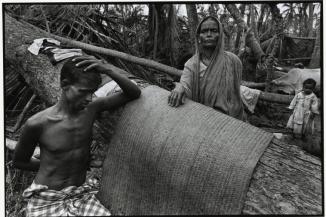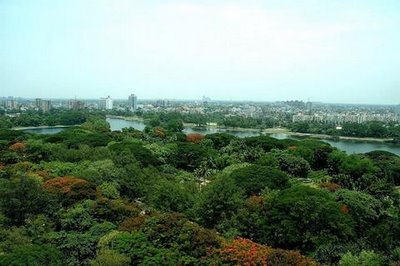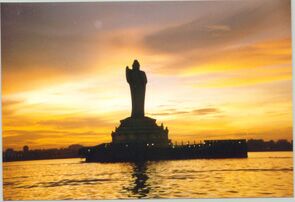8th September, is International Literacy Day.
This date has powerful resonances for me. On this day, in 1998, we had organised a women and children’s rally, in Priya Manna Basti, a jute-workers’ settlement in Howrah, the blighted industrial city across the river from Calcutta.
That was a very special occasion indeed, in the early days of our community empowerment initiative in Howrah slums. We had been working on women’s literacy (in Urdu), and we had also just started Talimi Haq School (Right to Education School), a non-formal learning centre for poor and working children. Hence we thought it was appropriate to observe Literacy Day.
There was also a funny aside to that successful rally. We had made arrangements for
biryani (a fragrant, succulent rice and meat dish) to be cooked, to feed all the rallyists after the programme. The responsibility for the
biryani had been given to a local man, who had solicitously volunteered to help. On the morning of the rally, Amina and Huma, my colleagues in PM Basti, discovered that this man had other plans of his own. He had organised a party for his wife’s birthday. And the feast for his party – was to be our rally
biryani! And so they intervened, ejected the fellow and took charge of the cooking. And everything eventually turned out fine.
Most of all, I remember singing out resonantly with the children, as our rally wound its way through the narrow slum lanes, the beautiful song that used to be broadcast over national television in the late-80s, under the National Literacy Mission:
Padna likhna sikho, o mehnat karne walo
Padna likhna sikho, o bhook se ladne walo
Ah aah ih eeh ko pehchano, alif ko likhna sikho
Kuh kha guh ghah ko apna hatiyaar banana sikho
Andhere se ujiyare tak paer badhana sikho
Padna likhna sikho, o mehnat karne walo
Padna likhna sikho, o bhook se ladne walo
In translation:
Learn to read and write O toiling people
Learn to read and write O you who’re battling hunger
Learn to recognise Ah Aah Ih Eeh, learn to write Alif
Learn to make Kuh Kha Guh Ghah your weapons
Learn to extend your foot from darkness towards light
Learn to read and write O toiling people
Learn to read and write O you who’re battling hunger
We observed International Literacy Day for a couple of years after that, with other women’s programmes. Then I swallowed the fact of our failure and inability to do anything substantive in the face of the utter perverse apathy and unresponsiveness of the authorities and institutions, and let this day pass. But my colleagues in Howrah, and especially Amina and Binod, always remember this day and observe it in some fashion.
To people in India - Calcutta and Bengal used to be identified with learning, culture, the arts, political consciousness etc. Even today, educated people of the older generation in other parts of the country hold this city and state in high regard. But the reality today is somewhat different.
I know that in my lifetime I shall not see a literate Calcutta, or even a Calcutta where every child receives basic education. And nothing I might do personally will make a difference. I know that those who have the power and responsibility to address such matters – just don’t care. Nor do the systems exist to enable such goals. Yet, I go on, trying to do whatever little I can, to make a small difference, to a few children, in one place.
I am in, of and for my city. But yet I stand apart, and am an exile in my own land. When one is out in the streets of Calcutta, at every moment everything all around defies law, orderliness, civility, rationality, taste, aesthetics, hygiene, sense, concern for the other. The image of the person of Calcutta that I am constantly filled with – is of a base, brutish, boorish, ugly, foul, filthy, violent, selfish, blind, malevolent, hateful, herd-driven, mob-mentality, beast.
And yet even that is not the full truth. A visitor to the city can also conclude that this is a warm, humane city, of sensitive, refined, aware people. Nature in this city – is also similarly ambiguous: this is the most frightfully hot, humid, infernal place; and yet, a gentle breeze, the quality of light, the feel-fragrance of the air, can be uplifting and endearing.
Poverty, squalor, filth, apathy, civic indiscipline etc – are also of course there in other cities of India. But yet perhaps Calcutta strikes one as different, and especially symbolic of all these things. There is also the long tradition of westerners’ gaze on Calcutta, which offends the educated, middle-class and affluent people here; they’d like their city to be well thought of, without themselves having to do anything in their lives towards that.
A concerned, aware citizen has to grapple with all this for herself, come to her own understanding, which is informed, unbiased, rational and compassionate, and act accordingly.
I like to think that there must be a higher reason and purpose behind Calcutta’s travails, something of significance for all of humanity. It is here that all the issues and challenges of life are out in the raw. Calcutta is something elemental. Here, every day, at every moment, darkness and light, knowledge and ignorance, apathy and compassion, high and low, good and evil - confront each other and battle. It is a theatre of humanity, the kitchen and alchemical laboratory of life, where the “human” is cooked and distilled.
I hope like the
biryani which we successfully rescued, something fragrant and delicious results!
 Natural disasters may strike a people, but its impact depends upon the existing situation within society. In that sense, the fundamental causes of the resultant devastation have to be found within the functioning of society, government and institutions, and in social relations.
Natural disasters may strike a people, but its impact depends upon the existing situation within society. In that sense, the fundamental causes of the resultant devastation have to be found within the functioning of society, government and institutions, and in social relations.


















